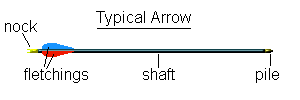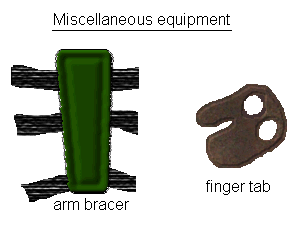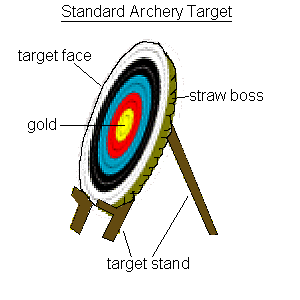 |
The Advertising banner above is the price we pay for this web space :
please inform the Webmaster if anything offensive or imappropriate is displayed.

The basic "tools" of the archer are the bow and arrow. These have not changed in basic concept for thousands of years, since they were first invented : a bent stick has a string stretched from one end to the other; by pulling on this string, tension is put on the stick which, when released, straightens and the string propels another stick, with a sharpened point at the front and some form of vanes to make it fly straight at the other.
ARROWS are the "business end" of archery and have come along way since they first developed from the spear or javelin.
 The modern arrow is usually made with a shaft of aluminium, carbon fibres, or a combination of these, although longbow and traditional archers still use wooden shafts. The modern arrow is usually made with a shaft of aluminium, carbon fibres, or a combination of these, although longbow and traditional archers still use wooden shafts.
The pointed end of the arrow is called the "pile" and varies in shape according to its use and the type of archery being practised: conventional arrow piles for target shooting are shaped like a sharp ended bullet. The opposite end of the arrow has a "nock" which clips the arrow on to the string firm enough so it doesn't fall off but loose enough to be propelled off the string when required!
The fletchings, once always made out of the flight feathers of large birds, may now be made from man-made materials to give greater durability and come in a variety of shapes and sizes, but still serve to make the arrow fly as straight and true to its target as possible. In most arrows, one of the fletchings will be a different colour from the other two and if you look closely you will see that it is fixed at right-angles to the nock : this is the "cock" fletching and the arrow should always be nocked with this fletching pointing away from the bow, ensuring that the other two fletchings will safely clear the bow on release.
Back to top

BOWS come in a wide variety of styles but their basic structure and mechanism is the same. They all rely on a string (or, in the case of Compound Bows, a system of strings) to propel the arrow towards, and hopefully into, its target. Regardless of its type, the parts of the bow remain the same : a handle with upper and lower limbs attached and a string stretched from one end of the bow to the other. The bow may be made of wood, fibreglass resin, laminated wood and/or synthetic materials, and the handle may be of the same materials or of lightweight alloy. "Takedown Bows" are bows in which the limbs can be removed from the handle for ease of transport as a fully-assembled bow may be five or six feet long or even longer. The names of the main parts of a basic bow are shown in the diagram to the right. The arrow rest may be attached to the left-hand side of the bow for a right-handed archer, or to the right for a left-handed archer (a right-handed archer holds the bow in his/her left hand.)
Bow strings can be made of natural or synthetic fibres, with the majority made out of Dacron. They consist of several strands twisted loosely together with the centre and two ends reinforced by whipping or "serving" to protect from friction from the bow (at the ends) and the arrow nock and the archer's fingers/finger tab (at the centre of the string.) The position for the arrow nock to clip onto the string is marked by a "nocking point" made by either additional serving in a different colour (or waxed dental floss, which has the additional advantage of being able to be melted on to make it secure) or commercially produced nocks clipped on to the string : the nocking point is essential in order to ensure consistency of arrow position on the bowstring.
|  |
 |
Back to top

 |
TABS AND BRACERS are essential equipment and probably the first items a beginner should buy. The function of the bracer is NOT to protect the arm - if the bow is held properly and the draw is correct the arm should be well out of the way of the bowstring - but to keep the sleeve from fouling the string on release. There are several types but the most usual is the short bracer illustrated, traditionally made of leather and fastened with buckles, press-studs, or increasingly with velcro. Finger tabs also come in various designs but they all serve the same purpose : not only do they protect the fingers when drawing and releasing the bowstring but they also provide a smooth surface for the string to slide off. |
Back to top

TARGETS are anything which the arrows are shot at : in Target Archery, the usual target is a coloured roundel with scoring zones marked on it, fixed to a suitable backing to prevent arrows travelling through it. The traditional target boss is made of straw but modern bosses may consist of compressed layers of card, fibreboard, plastics etc. - as long as the arrows cannot pass through the target. Scoring is either 9-7-5-3-1 (with 9 for anywhere in the Gold) or the colour zones may be subdivided to give 10 down to 1, with an inner gold scoring 10 and an outer gold scoring 9, and so on. If an arrow breaks the line between colours or zones it scores the higher points - thus an arrow on, or even touching, the line between red and gold scores 9. Any disputes are settled by the Field Captain.
 
Other archery disciplines use different types of targets - for details, see the appropriate page.
Back to top

OTHER ARCHERY EQUIPMENT : : once the Archery Bug has well and truly bitten, you may want to invest in other items of equipment : a Quiver is useful if not absolutely essential - different styles and materials are available commercially, but the most common type is the leather or fabric quiver which hangs from the belt and holds arrows with a pocket for score pads, spare fletchings and piles, small repair kits etc. The back quiver looks very stylish and is favoured by traditionalists, but there is an art to replacing your arrows in a back quiver without dropping them all over the floor! A ground quiver is a metal support which sticks into the ground on the shooting line and will hold both arrows and bow.
Other miscellaneous equipment - Bow Cases, Bowstringers etc - can be bought from archery supply companies : a web search will produce a long list of on-line suppliers with a startling array of equipment and gadgets for sale. It is, however, not always wise to buy "sight unseen" and we would recommend taking the advice of an experienced archer before spending large sums of money.
HOME |
INTRODUCTION |
HISTORY OF ARCHERY |
GETTING STARTED
DISCIPLINES |
PHOTO GALLERY |
LINKS AND WEBRINGS |
EMAIL
Backgrounds and graphics all specially made for this page : if you would like to use them, please email to ask for a copy.
|






